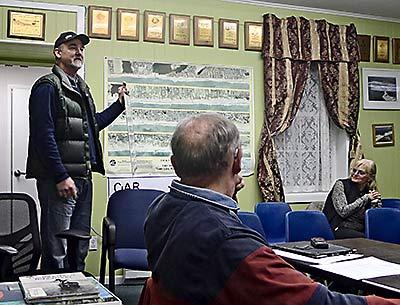Trustees Balk At Indian Wells Booze Ban

The battle over an alcohol ban at Indian Wells Beach in Amagansett intensified on Tuesday when Town Supervisor Larry Cantwell and Councilman Peter Van Scoyoc visited a meeting of the East Hampton Town Trustees. Before the meeting concluded, complaints were aired, pleasantries were extended, and one very controversial sign had been ripped from its post.
The trustees strongly opposed the East Hampton Town Board’s July 2014 decision to prohibit drinking on the beach during lifeguard-protected hours on weekends and federal holidays, to a distance of 1,000 feet in either direction from the road end. The action was taken in response to residents’ complaints that raucous, drunken parties had overtaken the beach and rendered it unfriendly to families. Ultimately the trustees, who manage most of the town’s beaches, waterways, and bottomlands on behalf of the public, agreed, grudgingly, to a ban, on a trial basis and with a sunset provision.
The law took effect on Aug. 2 and expired on Sept. 15. Yet a sign stating that alcohol is prohibited on the beach, without specifying dates, times, or where the ban begins and ends, was never removed — an enduring indication of the town board’s disregard for their jurisdiction, said the trustees.
Diane McNally, their presiding officer, was blunt in opening the discussion. “We really weren’t looking to prohibit alcohol on the beach again,” she told Mr. Cantwell and Mr. Van Scoyoc.
“This is straightforward, from my perspective,” Mr. Cantwell answered. “I think we need to do it again . . . if nothing else, for an insurance policy, and I would like the trustees to agree to what you agreed to last year.”
The trustees were not in an agreeable mood. “But the sign is wrong,” said Tim Bock. “You’re making it like it’s nothing. . . . You didn’t do anything you agreed to.”
“We’ll change the sign,” Mr. Cantwell said.
“Why is the sign still there when the law is over?” Deborah Klughers demanded. “Let’s give the public the truth.” She insisted that the sign be removed immediately.
Changes, including an attended booth on Indian Wells Highway that turned away taxis and buses, reduced the number of beachgoers toting large quantities of alcoholic beverages, Mr. Cantwell said. “Can you determinewhat exactly the impact was? That’s hard to do, because it was only in effect for a month. From my perspective, this is about ensuring that the beach isn’t going to turn into a drunken, wild party as it had in the last several years . . . in order to protect the people who use that as a resident-family beach. That’s the heart of this.”
The supervisor said the law did no harm, and he had received no complaints about it. Again, he asked the trustees to support the prohibition during the coming summer season. If John Courtney, the trustees’ attorney, wanted to provide the wording for a new sign, “I’d be happy to accept that,” he said.
The trustees were not finished venting. “It’s the perception that we did work so hard to come to that compromise, and it wasn’t reflected to the public,” Ms. McNally said. “It helped alleviate some problems . . . but you know what, damn it, it really made this board look like fools. And that’s the problem.”
If the sign accurately reflected the law, Mr. Van Scoyoc asked, would the trustees accept the prohibition for the coming season?
“I think that’s what you would like to walk away with,” said Stephanie Forsberg, the ancient body’s assistant clerk, “but what I’m sensing from this board is . . . there were so many discussions on coming up with a compromise, and it wasn’t carried through to be clarified for the public that there was a compromise agreed on, just that there was a ban in place.”
The trustees represent all user groups, she said. “We can’t just say this is going to be status quo.” Given the data — four summonses issued relative to the restricted area while the prohibition was in place — she questioned the necessity of a prohibition. Moreover, she said, “It’s a precedent we don’t want to set in multiple locations.”
Complicating any effort by the two governing bodies to reach an agreement, Mr. Cantwell confirmed that the town board would like the law adopted last year to be in place permanently, “so that we don’t have to have this discussion every year.”
The trustees said they would take the next two weeks to consider the supervisor’s request. With the debate concluded, Mr. Cantwell and Mr. Van Scoyoc left the meeting.
Turning their attention to other matters, the trustees had nearly completed the evening’s agenda when a figure appeared in the doorway. It was Mr. Van Scoyoc, bearing evidence that he and Mr. Cantwell had heard their concerns. In his hand was the sign that has been posted at Indian Wells Beach for the past eight months. The word “prohibited,” riddled with scratch marks, was nearly invisible.
